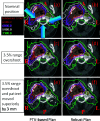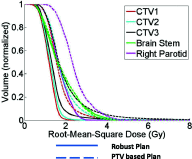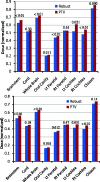Effectiveness of robust optimization in intensity-modulated proton therapy planning for head and neck cancers
- PMID: 23635259
- PMCID: PMC3651255
- DOI: 10.1118/1.4801899
Effectiveness of robust optimization in intensity-modulated proton therapy planning for head and neck cancers
Abstract
Purpose: Intensity-modulated proton therapy (IMPT) is highly sensitive to uncertainties in beam range and patient setup. Conventionally, these uncertainties are dealt using geometrically expanded planning target volume (PTV). In this paper, the authors evaluated a robust optimization method that deals with the uncertainties directly during the spot weight optimization to ensure clinical target volume (CTV) coverage without using PTV. The authors compared the two methods for a population of head and neck (H&N) cancer patients.
Methods: Two sets of IMPT plans were generated for 14 H&N cases, one being PTV-based conventionally optimized and the other CTV-based robustly optimized. For the PTV-based conventionally optimized plans, the uncertainties are accounted for by expanding CTV to PTV via margins and delivering the prescribed dose to PTV. For the CTV-based robustly optimized plans, spot weight optimization was guided to reduce the discrepancy in doses under extreme setup and range uncertainties directly, while delivering the prescribed dose to CTV rather than PTV. For each of these plans, the authors calculated dose distributions under various uncertainty settings. The root-mean-square dose (RMSD) for each voxel was computed and the area under the RMSD-volume histogram curves (AUC) was used to relatively compare plan robustness. Data derived from the dose volume histogram in the worst-case and nominal doses were used to evaluate the plan optimality. Then the plan evaluation metrics were averaged over the 14 cases and were compared with two-sided paired t tests.
Results: CTV-based robust optimization led to more robust (i.e., smaller AUCs) plans for both targets and organs. Under the worst-case scenario and the nominal scenario, CTV-based robustly optimized plans showed better target coverage (i.e., greater D95%), improved dose homogeneity (i.e., smaller D5% - D95%), and lower or equivalent dose to organs at risk.
Conclusions: CTV-based robust optimization provided significantly more robust dose distributions to targets and organs than PTV-based conventional optimization in H&N using IMPT. Eliminating the use of PTV and planning directly based on CTV provided better or equivalent normal tissue sparing.
Figures






Similar articles
-
PTV-based IMPT optimization incorporating planning risk volumes vs robust optimization.Med Phys. 2013 Feb;40(2):021709. doi: 10.1118/1.4774363. Med Phys. 2013. PMID: 23387732 Free PMC article.
-
Robust optimization for intensity-modulated proton therapy with soft spot sensitivity regularization.Med Phys. 2019 Mar;46(3):1408-1425. doi: 10.1002/mp.13344. Epub 2019 Jan 21. Med Phys. 2019. PMID: 30570164 Free PMC article.
-
Dosimetric benefits of robust treatment planning for intensity modulated proton therapy for base-of-skull cancers.Pract Radiat Oncol. 2014 Nov-Dec;4(6):384-91. doi: 10.1016/j.prro.2013.12.001. Epub 2014 Jan 14. Pract Radiat Oncol. 2014. PMID: 25407859 Free PMC article.
-
Robust radiotherapy planning.Phys Med Biol. 2018 Nov 12;63(22):22TR02. doi: 10.1088/1361-6560/aae659. Phys Med Biol. 2018. PMID: 30418942 Review.
-
Robust optimization in lung treatment plans accounting for geometric uncertainty.J Appl Clin Med Phys. 2018 May;19(3):19-26. doi: 10.1002/acm2.12291. Epub 2018 Mar 10. J Appl Clin Med Phys. 2018. PMID: 29524301 Free PMC article. Review.
Cited by
-
Investigate the Dosimetric and Potential Clinical Benefits Utilizing Stereotactic Body Radiation Therapy With Simultaneous Integrated Boost Technique for Locally Advanced Pancreatic Cancer: A Comparison Between Photon and Proton Beam Therapy.Front Oncol. 2021 Sep 22;11:747532. doi: 10.3389/fonc.2021.747532. eCollection 2021. Front Oncol. 2021. PMID: 34631584 Free PMC article.
-
Virtual particle Monte Carlo: A new concept to avoid simulating secondary particles in proton therapy dose calculation.Med Phys. 2022 Oct;49(10):6666-6683. doi: 10.1002/mp.15913. Epub 2022 Aug 22. Med Phys. 2022. PMID: 35960865 Free PMC article.
-
Improve dosimetric outcome in stage III non-small-cell lung cancer treatment using spot-scanning proton arc (SPArc) therapy.Radiat Oncol. 2018 Feb 27;13(1):35. doi: 10.1186/s13014-018-0981-6. Radiat Oncol. 2018. PMID: 29486782 Free PMC article.
-
Improve the dosimetric outcome in bilateral head and neck cancer (HNC) treatment using spot-scanning proton arc (SPArc) therapy: a feasibility study.Radiat Oncol. 2020 Jan 30;15(1):21. doi: 10.1186/s13014-020-1476-9. Radiat Oncol. 2020. PMID: 32000817 Free PMC article.
-
Beam angle comparison for distal esophageal carcinoma patients treated with intensity-modulated proton therapy.J Appl Clin Med Phys. 2020 Nov;21(11):141-152. doi: 10.1002/acm2.13049. Epub 2020 Oct 15. J Appl Clin Med Phys. 2020. PMID: 33058523 Free PMC article.
References
-
- Widesott L., Pierelli A., Fiorino C., Dell’Oca I., Broggi S., Catraneo G. M., Di Muzio N., Fazio F., Calandrino R., and Schwarz M., “Intensity-modulated proton therapy versus helical tomotherapy in nasopharynx cancer: Planning comparison and NTCP evaluation,” Int. J. Radiat. Oncol., Biol., Phys. 72, 589–596 (2008).10.1016/j.ijrobp.2008.05.065 - DOI - PubMed
-
- Lomax A. J., Pedroni E., Rutz H., and Goitein G., “The clinical potential of intensity modulated proton therapy,” Z. Med. Phys. 14, 147–152 (2004). - PubMed
Publication types
MeSH terms
Grants and funding
LinkOut - more resources
Full Text Sources
Other Literature Sources
Medical

